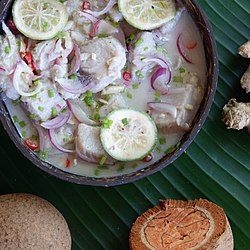 Kinilaw na tanigue with tabon-tabon and biasong | |
| Alternative names | kilawin, kilau, kinilau, lataven, binakhaw |
|---|---|
| Course | Appetizer |
| Place of origin | Philippines |
| Serving temperature | Room temperature, cold |
| Main ingredients | Seafood/vegetables, vinegar, calamansi (or other sour fruits), onion, ginger, salt, black pepper |
| Variations | kilawin, lawal, biyaring |
| Similar dishes | Hinava, 'ota 'ika, kelaguen, poke, ceviche |
Kinilaw (pronounced [kɪnɪˈlaʊ] or [kɪˈnɪlaʊ], literally "eaten raw") is a raw seafood dish and preparation method native to the Philippines.[1] It is more accurately a cooking process that relies on vinegar and acidic fruit juices (usually citrus) to denature the ingredients, rather than a dish, as it can also be used to prepare meat and vegetables.[2] Kinilaw dishes are usually eaten as appetizers before a meal, or as finger food (Tagalog: pulutan) with alcoholic drinks.[3] Kinilaw is also sometimes called kilawin, especially in the northern Philippines, but the term kilawin more commonly applies to a similar lightly grilled meat dish.[4]
- ^ Cite error: The named reference
oxfordwas invoked but never defined (see the help page). - ^ Cite error: The named reference
pinoywitwas invoked but never defined (see the help page). - ^ "Kinilaw na Malasugi / Swordfish Seviche". Market Manila. April 23, 2006. Retrieved January 16, 2017.
- ^ Elena Peña (June 24, 2016). "Wow! Kinilaw". The Philippine Star. Retrieved January 16, 2017.